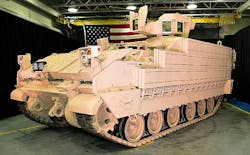Fiscal 2018 proposed DOD budget would increase Pentagon spending to highest levels since 2012
Proposed spending levels for fiscal 2018, which begins next Oct. 1, include a base budget of $574.5 billion, and an overseas contingency operations budget of $64.6 billion. This would add 64.6 billion to the DOD budget, compared to this year's request.
The lion's share of proposed defense budget increases for next year are in the base accounts, which include procurement, research, and operations and maintenance.
The proposed fiscal 2018 defense base budget is for $574.5 billion -- a 10 percent hike from this year's base budget request of $521.8 billion. The 2018 overseas contingency operations (OCO) budget, which supports continuing military operations is relatively flat at $64.6 billion, down slightly from this year's OCO budget request of $65 billion.
Next year's DOD budget request contains $125.23 billion for procurement, which is down 6.2 percent over 2017's procurement request of $133.5 billion. The procurement budget generally contains spending for new military ships, aircraft, land vehicles, and other military equipment.
The U.S. Army, Navy, and Air Force all have cuts in their procurement budgets next year compared to this year. All three services have cuts to their aircraft procurement budgets next year, while the Army budget has increases for weapons and tracked combat vehicles, missiles and ammunition. The Navy would see increases to its shipbuilding and ammunition budgets, and the Air Force would see increases to its space and ammunitions budgets.
The Army proposed to buy 60 remanufactured M2 Bradley Fighting Vehicles for $200 million in this budget, as well as 107 Armored Multi-Purpose Vehicles (AMPVs) for $447.6 million.
The U.S. Marine Corps, meanwhile, would see a healthy 27 percent increase in its procurement budget, which would rise to $2.13 billion, compared to 2017 levels of $1.68 billion.
Related: Military electronics spending for communications and intelligence heading upward in 2017
Among the biggest increases in Next year's budget represents a strong commitment to U.S. military weapons and capabilities development, with a research, development, test, and evaluation (RDT&E) request of $82.33 billion -- the highest DOD RDT&E request in more than 10 years.
Next year's Pentagon RDT&E budget request is up more than $11 billion -- or 15.2 percent -- over 2017's RDT&E request of $73.32 billion. This request includes across-the-board increases in basic and applied military research, advanced technology development, advanced component development and prototypes, system development and demonstration, management support, and operational systems development.
The 2018 DOD budget request also includes a proposed 6 percent increase in operations and maintenance, which consists of spending for warship steaming hours, aircraft flight hours, and other expenses related to normal military operations and training. Next year's budget calls for spending $82.33 billion for operations and maintenance, which is up from 2017 levels of $72.32 billion.
Learn more: search the Aerospace & Defense Buyer's Guide for companies, new products, press releases, and videos

